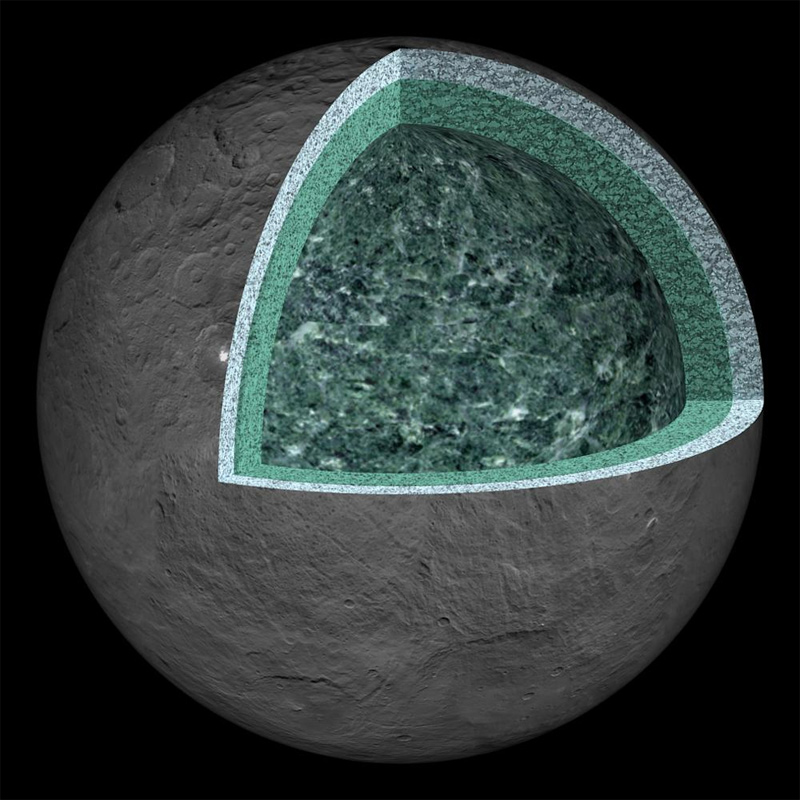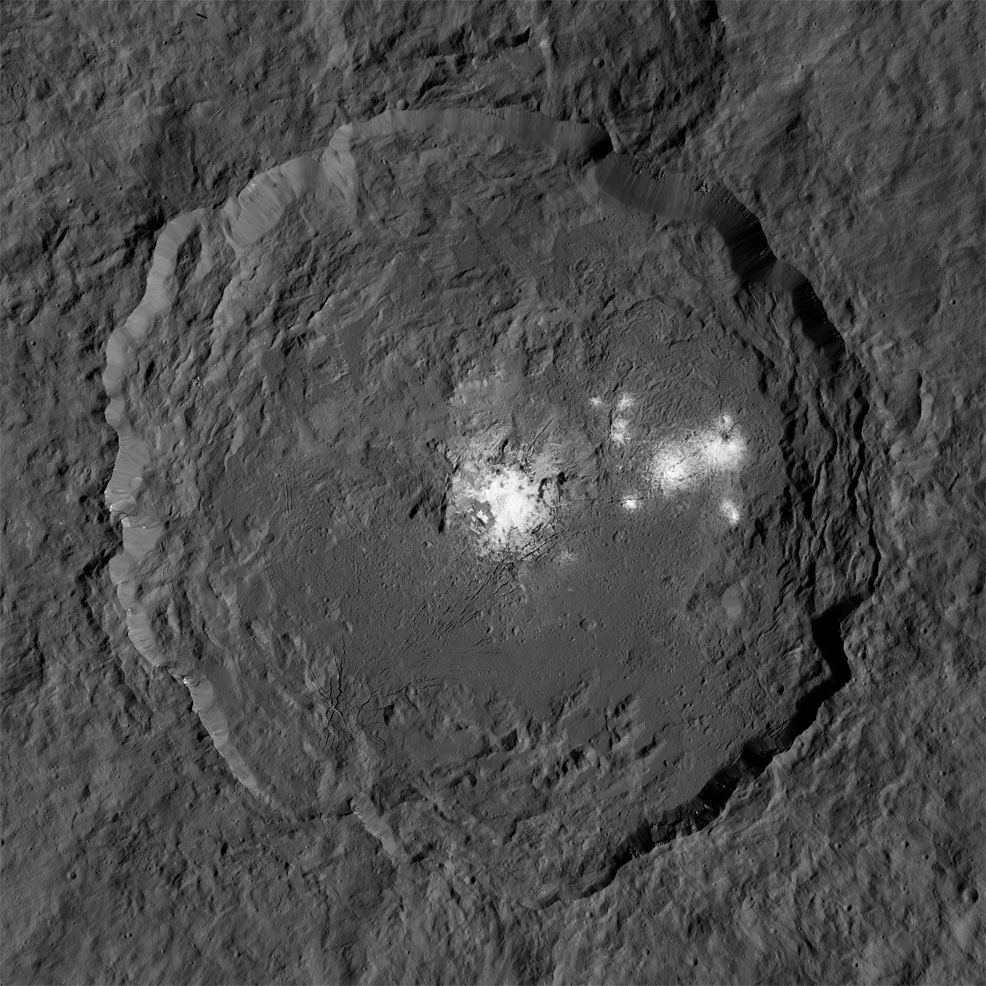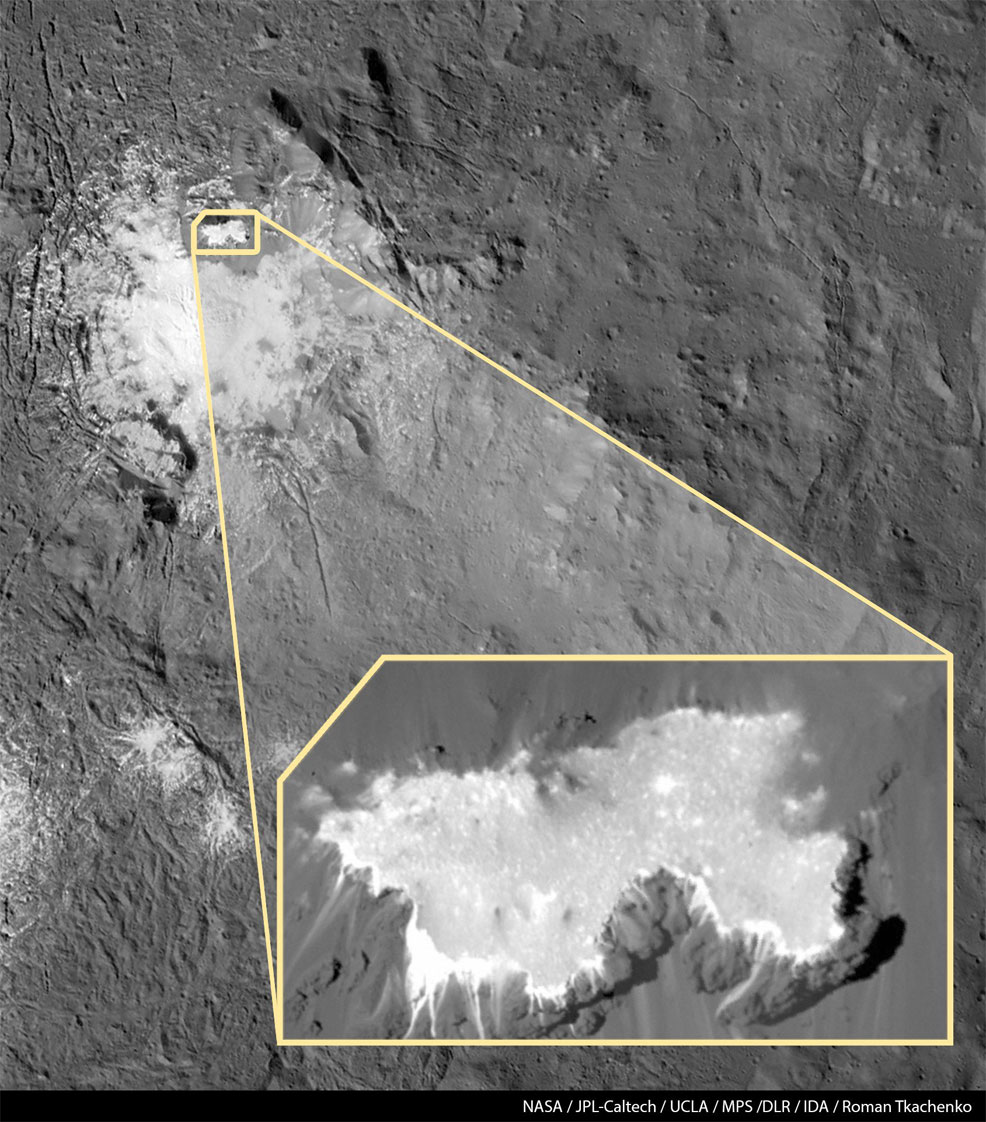
11th August 2020 Ceres confirmed to be water-rich world The dwarf planet Ceres is confirmed to be a water-rich body, containing a deep reservoir of brine, based on analysis of gravity data and other measurements from the Dawn mission.
NASA's Dawn spacecraft, which arrived at Ceres in March 2015, became the first probe to image and study this body at close range. It gave scientists extraordinary close-up views of the dwarf planet – the largest member of the asteroid belt between Mars and Jupiter – which at 940 km (580 miles) in size is the only object in the belt to be rounded by its own gravity. By the time the mission ended in October 2018, the orbiter had dipped to less than 35 km (22 miles) above its surface, revealing crisp details of mysterious "bright" regions (pictured below). Scientists later identified these as deposits of sodium carbonate – a compound of sodium, carbon, and oxygen. They likely came from liquid that percolated up to the surface and evaporated, leaving behind a highly reflective salt crust. Until now, the origin of that liquid had not been determined. However, after multiple studies of data collected near the end of the mission, Dawn scientists have concluded that the liquid came from a deep reservoir of brine, or salt-enriched water. By analysing Ceres' gravity, they learned more about the dwarf planet's internal structure and were able to determine that the brine reservoir is about 40 km (25 miles) deep and hundreds of miles wide. Ceres lacks the internal heating generated by gravitational interactions with a large planet, as is the case for icy moons of the outer Solar System. But the new research confirms that Ceres is a water-rich world like other icy bodies such as Europa, Enceladus and Ganymede. These latest new studies focused on the 92 km (57 mile) Occator Crater, home to the most extensive bright areas.
The findings, which also reveal the extent of geologic activity in Occator Crater, appear in a special collection of papers published yesterday by Nature Astronomy, Nature Geoscience, and Nature Communications. "Dawn accomplished far more than we hoped when it embarked on its extraordinary extraterrestrial expedition," said Marc Rayman, the Mission Director at NASA's Jet Propulsion Laboratory in Southern California. "These exciting new discoveries from the end of its long and productive mission are a wonderful tribute to this remarkable interplanetary explorer." Not only are these bright regions young – some less than 2 million years old – the geologic activity driving these deposits could be ongoing. This conclusion depended on scientists making a key discovery: salt compounds (sodium chloride chemically bound with water and ammonium chloride) concentrated in the region highlighted below, an area known as Cerealia Facula. On Ceres' surface, salts bearing water dehydrate relatively quickly, within hundreds of years. But Dawn's measurements show they still have water, so the fluids must have reached the surface very recently. This is evidence both for the presence of liquid below the region of Occator Crater and ongoing transfer of material from the deep interior to the surface.
The scientists found two main pathways that allow liquids to reach the surface: "For the large deposit at Cerealia Facula, the bulk of the salts were supplied from a slushy area just beneath the surface that was melted by the heat of the impact that formed the crater about 20 million years ago," said Principal Investigator of the Dawn mission, Carol Raymond. "The impact heat subsided after a few million years. However, the impact also created large fractures that could reach the deep, long-lived reservoir, allowing brine to continue percolating to the surface." Some evidence of recent liquids in Occator Crater comes from the bright deposits, but other clues come from a series of interesting conical hills that are reminiscent of Earth's pingos – small ice mountains in polar regions formed by pressurised groundwater. Such features have been spotted on Mars, but the discovery of them on Ceres marks the first observation on a dwarf planet. Infrared imaging also revealed the presence of hydrohalite – a material known to be common in sea ice but never observed off Earth, until now. "We can now say that Ceres is a sort of ocean world, as are some of Saturn's and Jupiter's moons," said Maria Cristina De Sanctis, from Rome's Istituto Nazionale di Astrofisica. "The material found on Ceres is extremely important in terms of astrobiology. We know that these minerals are essential for the emergence of life." In the coming decades, perhaps NASA or another space agency will return to Ceres with a sample gathering mission. In the more distant future, a robotic probe could drill down and explore the sub-surface environment.
--- Follow us: Twitter | Facebook | Instagram | YouTube
Comments »
If you enjoyed this article, please consider sharing it:
|









